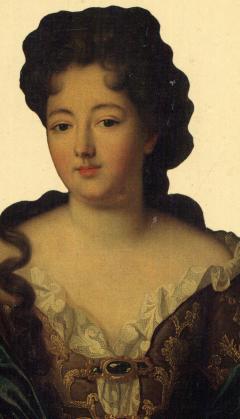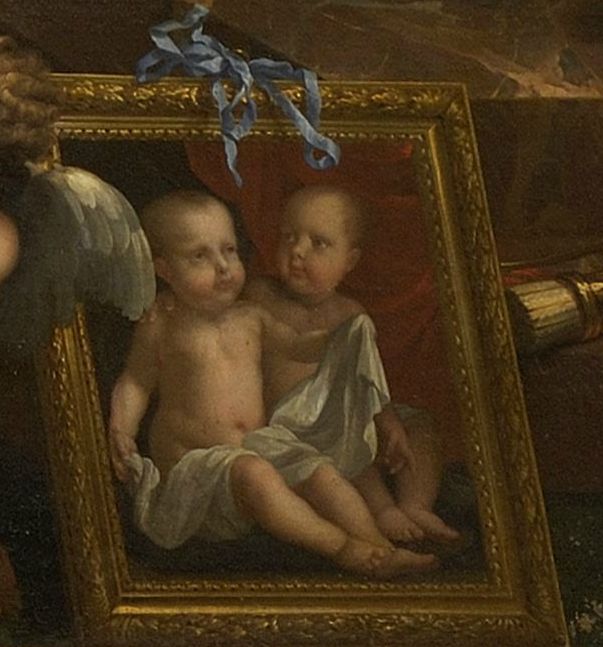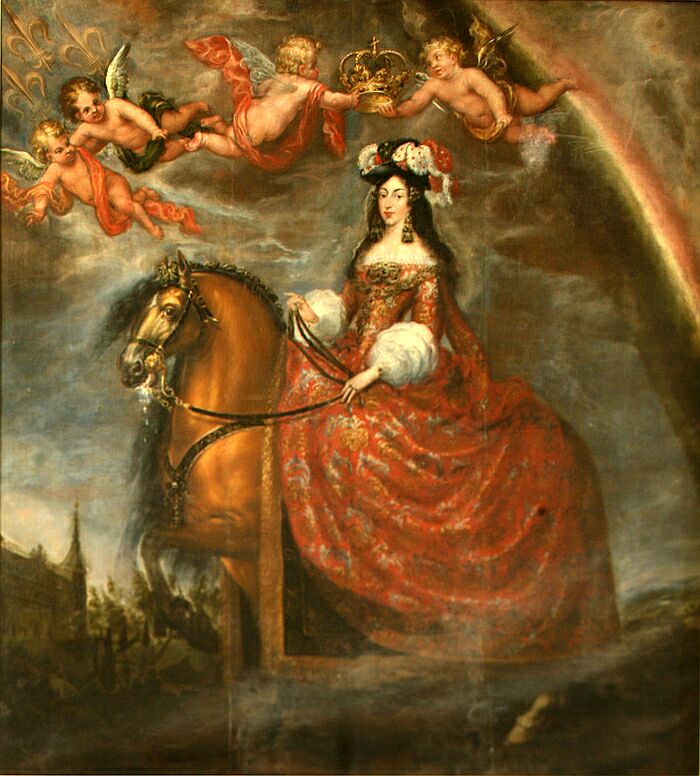Françoise-Marie de Bourbon, Duchesse d’Orléans
Françoise-Marie was the youngest illegitimate daughter of Louis XIV and Madame de Montespan. She was born 4 May 1677 at the château de Maintenon, but not given into care of Madame de Maintenon, because the Marquise was not happy the King and la Montespan were still sharing beds.

She grew up in the care of the Mesdames de Monchevreuil, de Colbert and de Jussac instead, like her older brother Louis-Alexandre. As she was four years old, she received the courtesy title of Mademoiselle de Blois, which was previously held by her half-sister Marie-Anne, upon her legitimisation by the King. Like with her other siblings, the legitimisation document does not state the name of the mother, out of fear Monsieur de Montespan might claim the children as his own.
Mademoiselle de Blois had much of her mother’s beauty and was, according to Madame de Caylus, naturally timid, glorious, and a little beauty with a beautiful face and hands, completely in proportion. From her father, she inherited an orderly mind as well as his sense for injustice or harshness… and a whole lot of pride. Françoise-Marie was very proud of the royal Bourbon blood in her veins, so much that people joked she never forget that she was the King’s daughter, even when on the chaise percée. Her groom nicknamed her Madame Lucifer.
Louis XIV always had a weak spot for his illegitimate children and sought to marry them well, in order to establish them at court. As illegitimate but legitimised children of the King, they had a place at court, of course, but many saw them as the royal bastards and not as the grand princes and princesses Louis XIV saw them. To change that, the King arranged for his sons and daughters to marry into the great noble houses of France. Marie-Anne, the former Mademoiselle de Blois, and Louise-Françoise both married a prince du sang. Françoise-Marie’s match should be even better…. in Louis’ eyes at least.
He took in mind to marry Mademoiselle de Blois, his favourite daughter, to the best bachelor available on the market. The intended groom was the son and heir of Monsieur and Madame, thus the King’s nephew and the future head of the house of Orléans. What the King thought to be a good match, was met with strong opposition by pretty much everyone else. Especially the mother of the intended groom. Monsieur and Madame did not have much in common, but the one thing they had in common was that they wanted the best for their children and to preserve their ranks and that of their house. For Liselotte the suggested marriage was a big non and Monsieur was not that happy about it either. Madame had a strong dislike for bastards, including royal ones.

A whole lot of persuading was needed to carry on. It was not too difficult for Louis to make his brother agree. Louis promised Philippe a whole lot of favours for his son, including high military positions, and apparently bribed the Chevalier de Lorraine with 100.000 livres to speak good of the match to Philippe. One of the Chevalier’s friends, a certain Dubois, was introduced into the household of Philippe’s son to do the trick there. In the end, both father and son were more inclined towards the match… but Louis knew that Madame would never agree to it. Luckily for him, he only needed the oui of Monsieur and his son, then known as the Duc de Chartres.
Liselotte got wind of the whole thing and confronted her son shortly after. He had to promise her he would not marry Mademoiselle de Blois. Such a marriage was a scandal and whatever was promised in return, would not make up for Chartres being the laughingstock of the court. The future of the family was in his hands and such a marriage was below him…
But who can say non when confronted with the royal authority in person? Liselotte slapped her son in front of the whole court as she heard he had agreed to the match. What about the bride? Je ne me soucie pas qu’il m’aime, je me soucie qu’il m’épouse. -I care not that he loves me, but that he marries me.- It is said that, although she was a fille légitimée de France she saw herself more like a proper fille de France and thought her agreeing to the marriage was a honour for the groom, because the groom was ‘only’ a petit-fils de France. Liselotte wrote: “all the ladies in waiting have made her believe that she did my son honour in marrying him; and she is so vain of her own birth and that of her brothers and sisters that she will not hear a word said against them; she will not see any difference between legitimate and illegitimate children.”
The marriage was celebrated with great pomp at Versailles 18 February in 1692 by Cardinal de Bouillon and followed by a huge banquet in the Galerie des Glaces. At it was time to withdraw, Cardinal de Bouillon blessed the wedding-bed, the bride was handed her night-shirt by Mary of Modena, the groom by James II. Madame de Montespan, mother to the bride, was not invited to the wedding.
Mademoiselle de Blois thus became the Duchesses de Chartres and as such outranked her older sisters. They did not like that one bit, which lead to everlasting rivalry between them. The new Duchesse ranked as petite-fille de France now and was a Altesse Royale. She was entitled to travel wherever the King went, to sup with him and to sit on a proper chair. She was the third highest ranking woman, while her older sisters, formerly above her in rank, were suddenly below her. Proud as she was, she let them of course feel the shift in rank whenever she could. Her sisters missed also out in matters of dowry, Françoise-Marie got more than both of them together from their papa.
Liselotte was not too fond of her daughter-in-law. She said Françoise-Marie did nothing else than lounging on a chaise, eating and that she got completely drunk at least three times a week. Her husband soon got mistresses, which Françoise-Marie did not mind in first. Apparently the only thing that prevented herself from getting a lover, was that she was too lazy for it.

Françoise-Marie and Philippe had eight children, born between 1693 and 1716, of which seven reached adulthood. The Duchesse was a bit annoyed that her children were not recognised as grandchildren of a King. Saint-Simon wrote: “(she) had a head filled with fantasies that she could not realise… Not content with the modern rank of Granddaughter of France, which she enjoyed through her husband, she could not bear the idea that her children were only Princes of the Blood and dreamed up a rank for them that was betwixt and between…Great-Grandchildren of France.”
As Monsieur died in 1701 due to a stroke, following an argument he had with the King about his son showing off his pregnant mistress, his son inherited the title Duc d’Orléans. The couple took over Monsieur’s residences, the Palais-Royal in Paris and the chateau de Saint-Cloud, and took up a lavish lifestyle. The new Duc d’Orléans amused himself in libertine ways, the Duchesse lead a more quiet life in company of selected ladies of the court. In 1709, upon the death of Henri-Jules de Bourbon, the rank of first princes of the blood was taken from the Condé branch and given to that of Orléans.
Saint-Simon paints the following picture of the Duchesse in 1710: “in every way majestic; her complexion, her throat, her arms, were admirable; she had a tolerable mouth, with beautiful teeth, somewhat long; and cheeks too broad and too pendant, which interfered with, but did not spoil her beauty. What disfigured her the most were her eyebrows, which were, so to speak, peeled and red, with very little hair; she had, however, fine eyelashes, with well-set, chestnut-coloured hair. Without being humpbacked or deformed, she had one side larger than the other, which caused her to walk awry; and this defect in her figure indicated another, which was more troublesome in society and which inconvenienced herself.”
Upon the death of Louis XIV in 1715, the Duc d’Orléans was appointed Regent of France for the young Louis XV, which made Françoise-Marie the most important woman of France. As the Regent died in 1723, the Duchesse retired to Saint-Cloud. She outlived him twenty-six years and died on 1 February in 1749 at the Palais-Royal, as the last child of Louis XIV.



